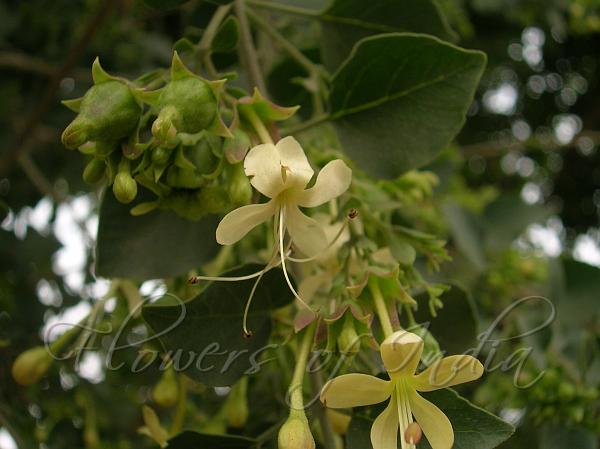|
| Sage Glory Bower |
|

|

| File size | 1097609 |
| Original date | 12/10/06 3:45 PM |
| Resolution | 2048 x 1536 |
| Flash | Flash did not fire, auto |
| Focal length | 8.0mm |
| Exposure time | 1/109s |
| Aperture | 3.2 |
| Focus Distance | |
| Metering Mode | Partial |
| Camera make | NIKON |
| Camera model | E3700 |
| Sensor type |
|
|
|
|
Photo: |
Botanical name: Clerodendrum phlomidis Family: Verbenaceae (Verbena family)
Synonyms: Clerodendrum phlomidis var. rubrum
Synonyms: Clerodendrum phlomidis var. rubrum
Sage Glory Bower is a fairly common shrub of arid plains, low
hills, deserts of Sind, Punjab and Baluchistan,1.5-3 m tall, stem
ashy-grey, branches velvety. Leaves are opposite, ovate to
rhomboid-ovate, 1.5-5 cm long, 1-3 cm broad, entire to wavy-toothed,
pointed to blunt. Leaf-stalks are up to 2.5 cm long. Flowers are
creamy-white or pale yellowish, about 1.5 cm across. Flower-stalks are
5-10 mm long, densely hairy, bracts ovate lanceshaped. Calyx is
bell-shaped, hairless, pale or somewhat yellowish green, somewhat
inflated, 5-lobed, Sepals are 4-5 mm long, ovate-triangulate,
Flower-tube is 2-2.5 cm long, much narrower than the calyx, velvety
outside. Petals are 5, nearly equal, ovate-elliptic, 7-8 mm long,
blunt. Drupe is obovoid, 8-12 mm long, black, wrinkled, usually
4-lobed, enclosed by the persistent calyx, seeds oblong, white.
Sage Glory Bower is found in Pakistan, India, Sri Lanka and Burma.
Medicinal uses:  Root is bitter tonic and given in convalescence of measles. Juice of
leaves is alterative and given in neglected syphilitic complaints. The
root is given as a demulcent in gonorrhoea, and decoction of the plant
is considered as an alterative. It helps cure stomach troubles and
swellings in cattle.
Root is bitter tonic and given in convalescence of measles. Juice of
leaves is alterative and given in neglected syphilitic complaints. The
root is given as a demulcent in gonorrhoea, and decoction of the plant
is considered as an alterative. It helps cure stomach troubles and
swellings in cattle.
 Root is bitter tonic and given in convalescence of measles. Juice of
leaves is alterative and given in neglected syphilitic complaints. The
root is given as a demulcent in gonorrhoea, and decoction of the plant
is considered as an alterative. It helps cure stomach troubles and
swellings in cattle.
Root is bitter tonic and given in convalescence of measles. Juice of
leaves is alterative and given in neglected syphilitic complaints. The
root is given as a demulcent in gonorrhoea, and decoction of the plant
is considered as an alterative. It helps cure stomach troubles and
swellings in cattle. | Identification credit: Navendu Pagé | Photographed in Garden of Five Senses, Delhi. |
• Is this flower misidentified? If yes,